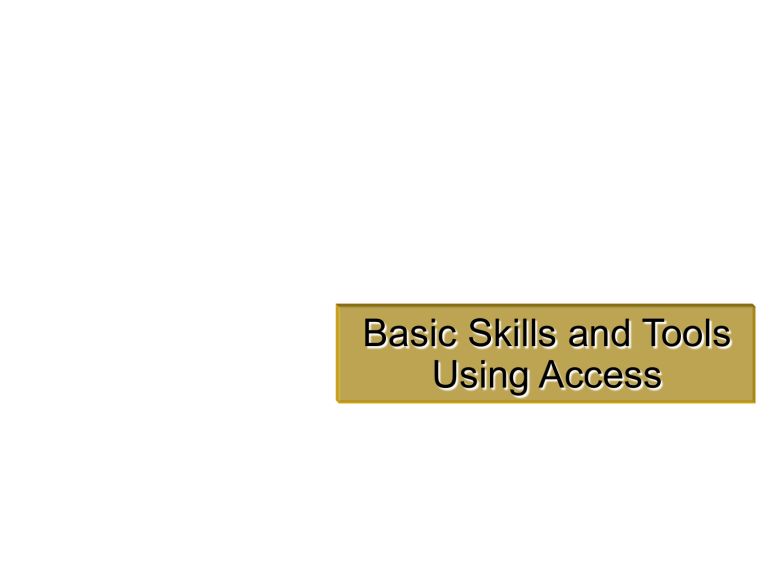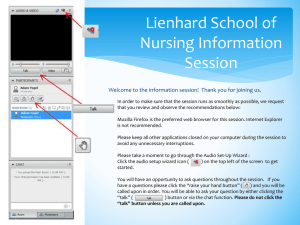Microsoft Access Basics: Database Creation & Table Relationships
advertisement

Basic Skills and Tools Using Access McGraw-Hill/Irwin © 2008 The McGraw-Hill Companies, All Rights Reserved LEARNING OUTCOMES 1. Describe the primary functions using Microsoft Access 2. Describe the steps for creating a new database file using Microsoft Access 3. Describe the steps for creating and modifying a table and fields using Microsoft Access 4. Describe the steps for creating relationships between tables using Microsoft Access T6-2 INTRODUCTION TO ACCESS • Microsoft Access is a powerful database program that allows you to enter and organize large amounts of data • Access allows you to relate tables and databases to one another, it is often referred to as a relational database T6-3 INTRODUCTION TO ACCESS • A relational database is a group of tables related to one another by common fields – A table (or datasheet) looks similar to a spreadsheet – Each row in the table contains all the data for a single record – Each column in the table represents a specific data value called a field – All records have the same fields T6-4 Creating A New Blank Database • To start a new database using Microsoft Access, click the Blank Database option in the New File task pane • The first thing you do is name your database • In Access, the database file cannot be moved to another disk or folder using the Save As command T6-5 Creating A New Blank Database • To create a blank database, follow these steps: 1. If the New File task pane is not visible, show it by clicking the New toolbar button, selecting File, New, or pressing Ctrl + N 2. Click the Blank Database command in the New area of the New File task pane 3. Select a location to save the file and enter Slopeside Bikes for the database file name in the File New Database dialog box 4. Access will save the new, blank database in the specified database file (which will have the .mdb extension), and open the Database window within the main Access window T6-6 Creating A New Blank Database T6-7 Opening An Existing Database • When you start Access, the task pane lists the most recently opened databases • To open a database: 1. Click the Open toolbar button 2. If necessary, from the Look-in: drop-down list, select the drive or location where the database is stored 3. If necessary, open the appropriate folder 4. Double-click the name of the database to open it, or click the name of the database once to highlight it; then click the Open button T6-8 Opening An Existing Database T6-9 Using The Database Wizard • Here is an overview on how to create a new database using the Database Wizard: 1. Click the On my computer... link in the Templates section of the New File task pane 2. If necessary, click the Databases tab 3. Click an icon to select a template, then click OK 4. Type a file name for your database 5. Click Next to go to the next step T6-10 Using The Database Wizard 6. The first step will present you with a list of tables that will be in your database – Some tables have optional fields – To add a field, click the check box in front of the field’s name – If you change your mind and want to remove a field from your database, click the check box to remove the checkmark 7. Next, select a graphic style for screen display and another style for printed reports 8. Finally, give the database a title and build the database T6-11 Using The Database Wizard T6-12 Using The Database Window And Object Views • Whenever a database is open, Access displays the Database window • The Database window serves as the central location for working with the database objects (tables, queries, forms, reports, etc.) in the opened database T6-13 Using The Database Window And Object Views T6-14 Using Table Views • You can open database objects in different views, depending on what you want to do • Datasheet view is the view to use when entering data – Use Design view when you want to change the structure or properties of the table • To open a table from the Database window: 1. In the Database window, click Tables on the Objects bar to display your list of tables 2. To automatically open a table in Datasheet View, double-click the name of the table 3. To change to Design view, click the View button on the toolbar 4. To switch back to Datasheet view, click the View button again T6-15 Using Table Views T6-16 CREATING AND MODIFYING TABLES • Access gives you several different ways to create tables: – Create a table with the Table Design Wizard – Create a table using data entry – Create a table in Design view T6-17 Creating A Table With The Table Design Wizard • To create a table using the Table Design Wizard: 1. Double-click Create table by using wizard in the Tables window 2. Select the type of table you need: business or personal 3. Select the Sample Table that best fits your needs 4. Select the fields from the sample that you want to include in your table T6-18 Creating A Table With The Table Design Wizard 5. Give your Table a meaningful name, such as CUSTOMER 6. Allow Access to set the Primary Key 7. Select what you want to do next: modify the table design, enter data in Datasheet view, or create a data entry form based on the table you just created 8. Click the Finish button to end the wizard and finalize your table T6-19 Creating A Table With The Table Design Wizard T6-20 Creating A Table In Design View • To create a table using the data entry method: 1. If necessary, click Tables in the Objects bar 2. Double-click Create table by entering data 3. The new table appears and is ready for data entry 4. Rename the fields that you are going to use by double-clicking the column name (Field1, Field2, etc.) and typing the new name (First Name, Last Name, etc.) T6-21 Creating A Table Using Data Entry T6-22 Creating A Table In Design View • To create a table using Design view 1. In the left column of the Database window, make sure that the Tables object is selected 2. Click Design on the Database dialog box 3. Create fields: a. Field Name = BikeID, Data Type = Number, Field Size = Long Integer, and make the BikeID the Primary Key b. Field Name = Description, Data Type = Text, Field Size = 25, Required = Yes c. Field Name = CostPerHour, Data Type = Currency, Required = Yes 4. Close the Table dialog box, and click Yes to Save the changes • Enter BIKE as the Table name T6-23 Creating A Table In Design View T6-24 Creating A Table In Design View • Create fields for each entry in the figure below: T6-25 Creating A Table In Design View • Create fields for each entry in the figure below: T6-26 Changing Data Types • By default, the data type for a new field is text • To change the data type for a field: 1. Open the table in Design view 2. Click the data type for the field that you want to change 3. Click the drop-down arrow to see the list of available data types 4. Select the appropriate data type for your data T6-27 Changing Data Types T6-28 Using The Input Mask Wizard • To ensure that users enter data in a particular format, use the Input Mask property • To use the Input Mask Wizard: 1. Open the CUSTOMER table in Design view 2. Click the Telephone field 3. Click the Input Mask box in the Field Properties pane 4. Click the Input Mask Wizard build button (the ... ellipse button) T6-29 Using The Input Mask Wizard 5. If you need to save the table, Access will prompt you to do so now 6. Select the Phone Number under the Input Mask column 7. Click the Next button to continue 8. In this step, you can modify the input mask or change the placeholder character – To change the placeholder character, click the drop-down arrow and select the character you want – You can test the new format by typing in the Try It: box 9. Click the With the symbols in the mask, like this: radio button 10. Click Next to go to the last step 11. Click Finish T6-30 Using The Input Mask Wizard T6-31 Using The Format Property • Use the format property to ensure that data are entered in a consistent format • To select a predefined format or enter a custom text format: 1. Open the BIKE table in Design view 2. Click the Cost Per Hour field 3. Click the Format drop-down arrow to display the list of predefined formats 4. Select the Currency format 5. Close the BIKE table window T6-32 Using The Format Property T6-33 DEFINING RELATIONSHIPS • Objects in your database are related to one another through relationships defined by common fields between tables • There are three types of relationships: 1. One-to-many 2. One-to-one 3. Many-to-many T6-34 DEFINING RELATIONSHIPS • When these fields have the same names, Access automatically creates the one-tomany relationship for you – The fields may have different names – In those cases, you may want to manually create the relationship using the Relationships window T6-35 Using The Relationships Window • To define relationships between tables follow these steps: 1. Open the Relationships window by choosing Tools, Relationships 2. Select each table listed (i.e., BIKE, CUSTOMER, and RENTAL) and click the Add button, then click the Close button 3. To define a new relationship, click and drag the Bike ID from the BIKE table and drop it on the Bike ID in the RENTAL table 4. Click the Create button in the Edit Relationships dialog box 5. Select the Enforce Referential Integrity box 6. Close the Relationships window, and Save the layout T6-36 Using The Relationships Window T6-37


